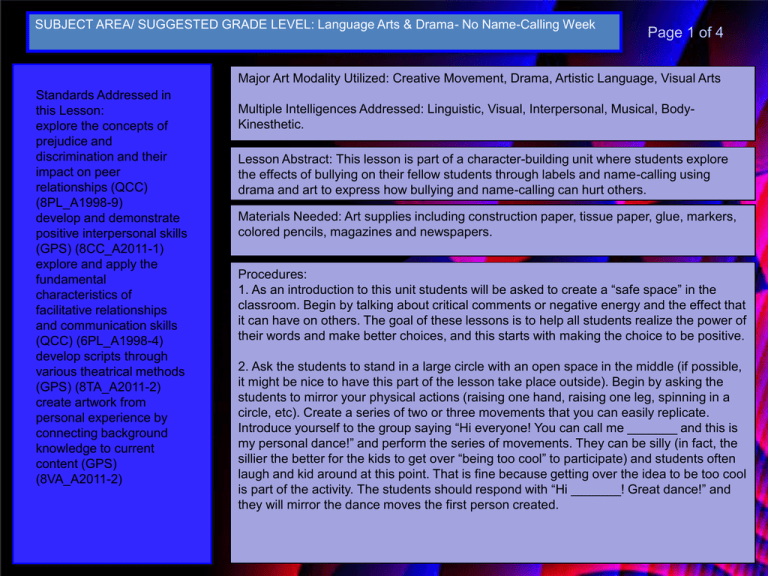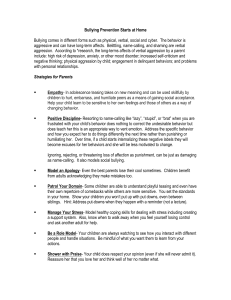Drama 3
advertisement

SUBJECT AREA/ SUGGESTED GRADE LEVEL: Language Arts & Drama- No Name-Calling Week Page 1 of 4 Major Art Modality Utilized: Creative Movement, Drama, Artistic Language, Visual Arts Standards Addressed in this Lesson: explore the concepts of prejudice and discrimination and their impact on peer relationships (QCC) (8PL_A1998-9) develop and demonstrate positive interpersonal skills (GPS) (8CC_A2011-1) explore and apply the fundamental characteristics of facilitative relationships and communication skills (QCC) (6PL_A1998-4) develop scripts through various theatrical methods (GPS) (8TA_A2011-2) create artwork from personal experience by connecting background knowledge to current content (GPS) (8VA_A2011-2) Multiple Intelligences Addressed: Linguistic, Visual, Interpersonal, Musical, BodyKinesthetic. Lesson Abstract: This lesson is part of a character-building unit where students explore the effects of bullying on their fellow students through labels and name-calling using drama and art to express how bullying and name-calling can hurt others. Materials Needed: Art supplies including construction paper, tissue paper, glue, markers, colored pencils, magazines and newspapers. Procedures: 1. As an introduction to this unit students will be asked to create a “safe space” in the classroom. Begin by talking about critical comments or negative energy and the effect that it can have on others. The goal of these lessons is to help all students realize the power of their words and make better choices, and this starts with making the choice to be positive. 2. Ask the students to stand in a large circle with an open space in the middle (if possible, it might be nice to have this part of the lesson take place outside). Begin by asking the students to mirror your physical actions (raising one hand, raising one leg, spinning in a circle, etc). Create a series of two or three movements that you can easily replicate. Introduce yourself to the group saying “Hi everyone! You can call me _______ and this is my personal dance!” and perform the series of movements. They can be silly (in fact, the sillier the better for the kids to get over “being too cool” to participate) and students often laugh and kid around at this point. That is fine because getting over the idea to be too cool is part of the activity. The students should respond with “Hi _______! Great dance!” and they will mirror the dance moves the first person created. SUBJECT AREA/ SUGGESTED GRADE LEVEL: Language Arts & Drama- No Name-Calling Week Area for Teacher Notes: Page 2 of 4 Procedures: (Continued) 3. Go around the circle and have each person take a turn creating a personal dance. Comment positively on similarities between the dances (“Great use of clapping and rhythm” etc) but they were also all unique. Ask students if they have any thoughts about how this activity might be related to the idea of bullying. Student responses might be anywhere from “We all looked goofy making up a dance but no one said anything” or “We all had a different type of dance but they were all good” etc. 4. Move students back into the classroom and ask them to list names or labels that they have heard people use (or that they have used themselves). These could be things like “Nerd” “Dork” “Stupid” “Retard” “Gay” “Emo” “Skater” “Idiot” “Jock” etc. Write these words on the board and ask the students to consider how it feels to be called a label instead of their name. Emphasize that we all have been called names throughout our lives (you may choose to share a personal story about a time you were bullied in your life) but that we can be a part of changing this negative element of our culture. Introduce the concept of “No Name-Calling Week” within you classroom (and the school at large, if possible). 5. Students should write a personal reflection of a time that they were called a name or teased or a time that they witnessed another student being bullied or called names. Help the students frame their responses by writing some guiding questions on the board: -When did this situation happen? -Where did it take place? -Who else was there? -How did the situation end? -How would you have liked it to end differently? SUBJECT AREA/ SUGGESTED GRADE LEVEL: Language Arts & Drama- No Name-Calling Week Page 3 of 4 Procedures: (Continued) 6. Students can take their reflections and they can choose to share them with the class or not-- however, working in small groups the students should come up with a scenario that can be based on a person's reflection or it can be a combination of events that happened in several reflections. The scenario script should include the real incident and a “better choice” ending that can involve the situation being resolved or dealt with in an appropriate manner. The students should play the different roles in their scenes and be prepared to share the scenes with the class. 7. After the scenes have been shared students should discuss their feelings about bullying and name-calling in general: do they think bullying is a problem at their school? Do they feel comfortable talking to teachers or adults about bullying? What do they do if they see someone being bullied? Etc. Try to lead the discussion to the ultimate question: what can you as students do to change the culture and get rid of bullying? 8. If possible show the students some examples of famous PSA ads and commercials over the years (Possible examples include Smokey the Bear “Only you can prevent forest fires” or Rosie the Riveter “We Can Do It!” or “Friends Don't Let Friends Drive Drunk”) Discuss with the students why these campaigns were effective at spreading a message or getting an idea across to an audience. Brainstorm ideas about themes or slogans to help people remember to be kind or not to call people names. Have the students use these slogans or themes as the inspiration for their PSA posters for “No Name-Calling Week.” Each student should create an example poster to encourage students to participate in No Name-Calling Week or to stop bullying in general. The poster should have creative visual elements and relate back to the central idea of Bullying Prevention. 9. Showcase finished posters in the hallway and hold a “Gallery Walk.” Give each student 10 Post-it notes to write comments on and stick the comments beside the art work. Use the poster rubric to evaluate the student work and allow them to take their poster along with their comments home. SUBJECT AREA/ SUGGESTED GRADE LEVEL: Language Arts & Drama- No Name-Calling Week Page 4 of 4 Assessment: Student learning objectives will have been met when students demonstrate a strong understanding of the nature of name-calling and bullying and recognize how such behaviors have a negative impact on the culture of the school. Performances and Posters should be graded using the appropriate rubrics. Resources/ Links: Link for PSA Examples: http://www.adcouncil.org/default.aspx?id=61 Link for Information on No Name-Calling Week: http://www.nonamecallingweek.org/cgi-bin/iowa/all/resources/index.html






